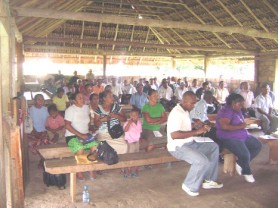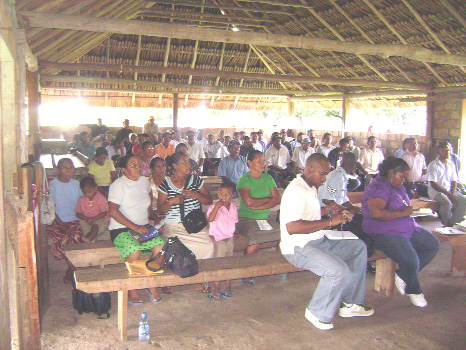Closer collaboration between villages and mining company, Romanex, is critical, residents said as a major gold mining project in southern Guyana is set to gain approval to begin operations.

Romanex Guyana Exploration Limited is awaiting an environmental permit from the Environmental Protection Agency (EPA) to begin large-scale alluvial gold mining in the Marudi Mountain, Deep South Rupununi, Region Nine. Last week the Environmental Assessment Board (EAB) held a public hearing in Aishalton, Deep South Rupununi to garner the views of residents on the proposed project. It was explained that while the hearing was not mandatory, because no written views on the draft Environmental and Social Impact Assessment (ESIA) had been received from residents, the Board decided to hold the meeting. Stabroek News was present at the meeting.
EAB Chairman Denise Simmons said the meeting, held last Tuesday, ended the review process and the Board would now have to decide whether to accept the ESIA and issue a permit. She said the comments raised would be incorporated into the report and within 30 days, they would decide whether to grant the permit. A public scoping meeting, also to garner the views of residents on the project, was held in the community last August.
Mainly residents of Aishalton attended last Tuesday’s meeting though there were representatives from Karaudarnau, the village closest to the site, as well as others from surrounding indigenous communities. The proposed mine is over 200 kilometres (km) from Lethem and 50 km from Aishalton. Karaudarnau is linked to the area by a trail and is 20.5km away.
A recurring concern was the “technical” information presented to residents. Simplifying the documents was important because persons can only make observations or comment on what they can understand, said Kid James, the Deputy Toshao of Aishalton. Indicating the draft ESIA report, he said he could understand certain parts but otherwise it was “strange language.” He asked whether the EPA could simplify the document.
“In terms of getting a simpler document; that is beyond us,” responded Geeta Singh, the head of the Environmental Management Division of the EPA. She said that the process was done according to regulations and currently, there was no legislation in place that said that the documents must be simplified. It was noted that the executive summary contained the basics of the project.
James also said that it was unfortunate that again, there was no representative from the community of Para Bara at the meeting because some of the creeks to be mined flow into the Kuyuwini River, which that community depends heavily upon. In response, Charles Ceres, the EIA consultant said that the operation would be a zero-discharge one and nothing would flow into the river. There was an erosion and sediment control plan, he added.
James, meantime, also expressed concerns about increased traffic on roads not built to handle large numbers and persons passing through the community to get to mining areas that would have opened up. He said that the village was already “pressured” to “get a handle” on persons passing through. He said residents wanted to know what skills would be required once the mine opened, while also acknowledging that Romanex had been providing some updates. “There is need for information sharing and stronger collaboration,” he added.
Earlier, Ceres had told the meeting that the ESIA was performed to conform to EPA guidelines as well as some from external agencies such as the World Bank. In presenting a summary of the findings of the draft ESIA, he said mining would be done on the alluvial flats, which were areas that bordered the creek beds and the creek bed itself. Nine creeks will be mined. According to Ceres, no gold was going to be recovered from a flowing creek. The creeks that were to be affected would be diverted and after mining would be restored to their original location, he said. The area to be mined was 800 feet above the surrounding area, said Ceres, who outlined some impacts the project would have, which he described as “minor.”
“This project is a zero-discharge project,” he asserted pointing out that a closed-loop system would be used whereby water used in the operation would be discharged into ponds for reuse and would not be released. Therefore there would be no impact on water quality, he said, adding that the project would entail progressive reclamation. “We expect the project will be carbon-neutral at the end of the rehabilitation exercise,” said Ceres. The question of the project and its impact on the Low Carbon Development Strategy had been raised.
He also told residents that there would be a community relations aspect, centralized hiring practices, training for persons and the company would do some upgrading of roads. The company planned to introduce chemical-free mining practices which could serve as a demonstration project to Guyana, Ceres added. He pointed out that there would be an Environmental Management Plan and an Environmental Monitoring Plan.
In defending his ESIA report regarding the concerns raised, Ceres said that these concerns were addressed in the document. With regard to inadequate information dissemination, he said that a committee would be established which would meet quarterly to conduct periodic reviews.
Meantime, while supporting the need for a simpler document, Aishalton Toshao Hildebrand James said he appreciated the way that Romanex conducted relations with the community. He said that it was smaller operations which were “more destructive.” He called for a more formal relationship with the company.
Toshao of Karaudarnau, Arnold Stephens also called for more information to be provided to communities and asked whether Romanex would be meeting with residents of the villages. In response, Romanex’s representative Esther Parks said that they would be holding meetings before mining started.
Ron James of Aishalton noting that the soil at Marudi was very fertile questioned whether this would be restored after the project was completed. Ceres responded that there was the reclamation plan.
One man, who identified himself as Vernon, said he lived and farmed at Marudi and asked what would happen to them. Parks acknowledged that some persons lived at Peace Creek, one of the areas to be mined and Ceres said that the Guyana Geology and Mines Commission (GGMC) would have to deal with this. However, GGMC Environ-mental Officer, Quincy Thom said that if it was not a titled settlement, he did not see the Commission playing any part and to his understanding, the people who lived there were pork-knockers. Vernon said that he had lived in the area for 30 years and over 100 persons were living there. Ceres said that in doing the baseline study, only two persons were seen in that area. Rufus Buckley, who said he also lived, mined and farmed at Marudi questioned who would do the replanting when the project was completed.
Edward Laud of Aishalton said that two other communities including Shea should also be involved in the process as one of the creeks, Paunch Creek flowed to Shea. However, this information was not verified. The Toshao of Shea, Lawrence Johnson was present and he said that if any mining were done in that particular river, it would have a great impact on the area. He said that recently he met some Brazilians going into the area to locate mining claims and he learnt that there a large number of claims had been issued. He expressed concern about this and was told that that information would have to be verified.
Meanwhile, Aishalton businesswoman, Dorothy James, asked whether Romanex could host a workshop for women in the communities to be educated on mining issues. She explained that when the men went to seek work, the women were left at home and needed to safeguard themselves.
While Romanex holds the mining licence, Shoreham Resources Limited, a Canadian exploration company had exercised an option to acquire 75% of the shares of Romanex, which is held by Infinito Gold Corporation (formerly Vannessa Ventures Incorporated). Shoreham has signed an agreement with a French mining company Rexma Participacions (Rexma), for that company to work in the Marudi Mountain Gold Project. The company had committed to a major expansion of production capacity within the next two years.
According to the project summary, the project will entail the excavation of mineralized gravel, the establishment of a mineral processing plant for the recovery of gold and the construction of supporting facilities, buildings and road.
No chemicals will be used and the project will serve as a demonstration of non-chemical recovery of gold from placer deposits. It is expected that the mine will operate 10 hours each work day and will process 600 cubic metres of mineralized gravel each day. The equipment has been sized to operate for 350 days per year. Average production will be 200,000 cubic metres per year at the beginning of the operation and this will increase to 400,000 cubic metres annually in year two, and this production level will be maintained for the remainder of the operation, the Summary states.
As regards ore recovery, the alluvial deposit will be mined by open pit methods in the creeks’ flats. Gold will be recovered by gravity separation using mobile screen and concentrator units. This will allow rehabilitation of mined out areas to occur as work advances, the project summary states.
The company also plans to construct an all-weather gravel surfaced roadway, linking Marudi to Aishalton, about 45 kilometres long. The company also envisions maintaining the 180 kilometres long road from Lethem to Aishalton in the dry season by periodic grading to facilitate transportation of operating supplies into the mine site. The company also plans to build a 600-metre airstrip at the site. (Gaulbert Sutherland)

